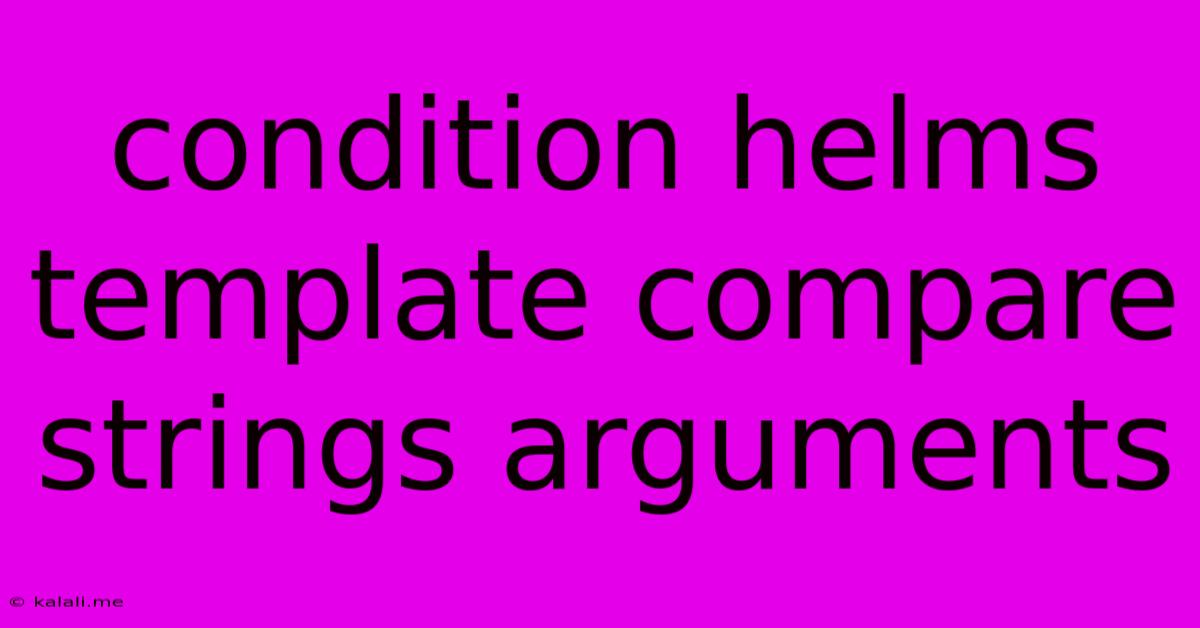Condition Helms Template Compare Strings Arguments
Kalali
Jun 01, 2025 · 3 min read

Table of Contents
Comparing Strings in Helm Templates: A Deep Dive into the cond Function
Helm templates are powerful tools for creating Kubernetes manifests dynamically. A common task within these templates is comparing strings to control the flow of your template logic. This article delves into how to effectively compare string arguments within Helm templates using the cond function, covering various scenarios and best practices. This will allow you to create more robust and adaptable deployments.
This guide will explore the effective use of the cond function to compare strings within your Helm charts. We'll cover different comparison types, handling potential errors, and best practices to make your templates cleaner and easier to maintain.
Understanding the cond Function
The core of string comparison in Helm templates revolves around the cond function. It acts as a conditional statement, evaluating a condition and returning different values based on the result. The basic syntax is:
{{ cond }}
For string comparisons, the <condition> part is where you'll utilize various comparison operators. Unfortunately, Helm doesn't offer direct string comparison operators like == or != within its templating language (Go templating). Instead, we leverage the eq and ne functions for equality and inequality comparisons respectively.
Comparing Strings for Equality (eq)
Let's illustrate comparing strings for equality using the eq function within the cond statement:
{{ cond (eq .Values.environment "production") "Production Deployment" "Development Deployment" }}
This snippet checks if the environment value from your values.yaml file is equal to "production". If true, it outputs "Production Deployment"; otherwise, it outputs "Development Deployment".
Comparing Strings for Inequality (ne)
Similarly, we can use the ne function to check for inequality:
{{ cond (ne .Values.database "postgres") "Using a non-Postgres database" "Using Postgres" }}
This example checks if the database value is not equal to "postgres". The output changes based on the result of the comparison.
Handling Empty or Missing Values
A crucial consideration is handling cases where a string value might be empty or missing. Direct comparison can lead to unexpected errors. Here’s how to handle such scenarios:
{{ $appName := .Values.appName }}
{{ cond (and $appName (eq $appName "my-app")) "This is my-app" "This is not my-app" }}
This example uses the and function to ensure that $appName is not empty before attempting the comparison. This prevents errors if the appName is not defined in the values.yaml.
Nested Conditional Statements
For more complex scenarios, you can nest cond statements:
{{ $env := .Values.environment }}
{{ $db := .Values.database }}
{{ cond (eq $env "production") (cond (eq $db "postgres") "Production Postgres" "Production - Other DB") (cond (eq $db "mysql") "Dev MySQL" "Dev - Other DB") }}
This example demonstrates nested conditions, providing more granular control based on multiple variables. Always strive for clarity and readability, even with nested conditions.
Best Practices
- Use meaningful variable names: Make your templates easier to understand by using clear and descriptive variable names.
- Keep conditions concise: Avoid overly complex nested conditions. Break them down into smaller, more manageable units if necessary.
- Comment your code: Add comments to explain the logic behind your conditional statements.
- Validate your
values.yaml: Ensure your input values are valid and consistent to avoid unexpected behavior.
By mastering string comparison techniques within Helm templates, you'll significantly enhance the flexibility and adaptability of your Kubernetes deployments. Remember to prioritize clarity, robustness, and maintainability in your template code. This approach will ultimately lead to more efficient and reliable infrastructure management.
Latest Posts
Latest Posts
-
When Is 90 More Than 100
Jun 02, 2025
-
How To Tell If Function Is One To One Precalculus
Jun 02, 2025
-
How To Connect Joist To Beam
Jun 02, 2025
-
The Prophecy Of The Chosen One The Jedi Path
Jun 02, 2025
-
Icloud Keeps Signing Me Out App
Jun 02, 2025
Related Post
Thank you for visiting our website which covers about Condition Helms Template Compare Strings Arguments . We hope the information provided has been useful to you. Feel free to contact us if you have any questions or need further assistance. See you next time and don't miss to bookmark.